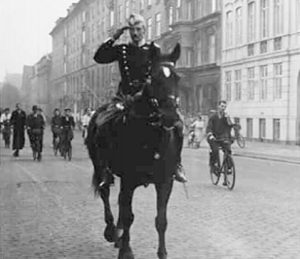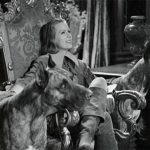Christian I was born in 1426 and became King of Denmark in 1448, King of Norway in 1450 and Sweden in 1457. In case this seems greedy he was also the founder of the Oldenberg royal line, being a son of the Count of Oldenberg and his lady Hedvig, the heiress of Schleswig and Holstein. He was monarch by election in Denmark, succeeding Christoph (of Bavaria to ensure more complication). Norway wanted him to replace their king, one Karl Knutsson (of Sweden to complicate matter more), and he was crowned king in Sweden too, though Karl K. was offended and ousted him in 1464.
To complicate the issue more the people elected him sovereign ruler of Schleswig/Holstein. It is all quite wondrous, for Christian was not a good king; he spent too much on himself and his glittering court, and was therefore always broke. When he married his daughter Margaret to James III of Scotland, he was expected to provide a dowry of 60,000 guilders. Not being able to find the complete sum he mortgaged the Orkneys and Shetland, getting 8000 guilders (which he never repaid). He did, however, found the University of Copenhagen in 1478: where did the money come from? Dying in 1481, he was succeeded by his son Hans I.
Christian II was born in 1481 and was also King of Denmark and Norway (1513 – 23), as well as Sweden from 1520 to 1523. In 1515 he married Elisabeth of Habsburg, sister of Charles V. In November, 1520, he orchestrated the massacre of most of the most important persons in Stockholm, Sweden, and as a result was driven out by Gustav I (Vasa line) in 1523, an act which put an end to the ‘Kalmar’ Union between the three kingdoms. Christian II got himself rapidly into Denmark, but a popular uprising pushed him out and into the Netherlands. Meanwhile the Scandinavians placed Christian’s uncle Frederick on the throne. Not being able to accept that he was unpopular, he got help from his brother-in-law Charles V, and tried to invade Norway in 1531. The Norwegians were not having this and he was captured, dying in 1559 in prison.
Christian III was born in 1503, the elder son (and successor) of Frederick I. By religion he was a Lutheran, and he imposed Protestantism on Denmark, Norway and Iceland, establishing the Lutheran State Church. Though it was not comical at all, he acceded to the throne in the middle of a civil war fought between Catholics and Protestants. As soon as he could, Christian arrested all the Catholic bishops in opposition and took their lands. He is known to Scandinavians as a Good Thing and a Good King because he encouraged and improved agriculture, translated the German Bible into Danish, and greatly strengthened the monarchy. His son Frederick succeeded him at his death in 1559.
Christian IV is probably the best remembered monarch in Scandinavia. He was born in 1577, son of Frederick II, whom he succeeded, though he had to rule under regents until 1596 because of his youth. He strengthened the army and navy, and almost rebuilt the city of Copenhagen, making it beautiful with elegant architecture and waterworks. Like all Vikings he was fond of battle, and invaded Sweden where the young Gustav II (Adolf) was king but failed to take Stockholm. Peace was made in 1613. He attached himself to the Protestant Union in 1625 to help his niece Elisabeth of Bohemia in the Thirty Years War – but was severely thrashed in catastrophic defeats near Hamelin (of ‘Pied Piper’ fame) and at Wallenstein in 1626. The power and prestige of Denmark steadily declined as a result. As if things were not bad enough, he foolishly went to war against Queen Christina of Sweden in 1643, losing the dominion of the Baltic he had previously won. He was succeeded by his son Frederick III.
Christian VII was born in 1749 and was King of Denmark and Norway from 1766 to 1808. He was cruelly treated by his tutor as a boy, and suffered from dementia praecox, though he managed to marry his English cousin Caroline Matilda, sister of George III (who suffered a similar mental disease). In 1768 he made a magnificent tour of Europe, accompanied by his doctor and friend Count Struensee, a privy councillor. But the good doctor was not good at all, for he became the Queen’s lover and seized power from his friend. In 1772 however he was arrested, tried for treason and executed, while naughty Caroline sailed off for Hanover. In 1784 the kingdom considered Christian quite mad enough to be replaced, and he was forced to relinquish control to his son Crown Prince Frederick, whon ascended the throne as Frederick VI.
Christian VIII was born in 1786 and was King of Denmark from 1786 to 1848 – fifty-two years – a goodly span especially in Scandinavia, where kings are changed as quickly as clothes. In 1814 Norway got a new constitution and a new king – Christian, but not for long because the king of Sweden kicked him out, putting himself on the Norwegian throne! Back again as simply the king of Denmark he revived the ancient Althing or Parliament of Iceland, which allowed free trading with that country. In 1848 he abolished absolute monarchy, a reform implemented by his son and successor, Frederick VII, and died.
Christian IX was born in 1818, a Prince of Glúcksburg. He succeeded as King of Denmark because Frederick VII had died without heirs. On becoming king in 1863 he was obliged (kings were no longer ‘absolute’) to sign the ‘November Constitution’, which incorporated Schleswig into the Danish kingdom. The headache of Schleswig/Holstein had begun. Prussia and Austria objected to this mini-Anschluss and declared war. Not surprisingly. Denmark lost both Schleswig and Holstein.
Christian recovered his dignity enough to make the first official royal visit to Iceland, on the thousandth anniversary of her settlement, where he supervised the signing of that country’s first Constitution – limited autonmy under a Governor. He died in 1906 and was succeded by his elder son who became Frederick VIII. Less importantly, but much more questionable, was the placing of Christian’s younger son on the Greek throne as King George I. Notwithstanding, Christian’s eldest daughter Alexandra married the Prince of Wales, the future Edward VII of Great Britain. Still in the marriage stakes, the youngest daughter married the future Tsar of Russia, Alexander III (q.v.). Christian’s distribution of royal children among other thrones greatly added to the notion of Queen Victoria’s being ‘the grandmother of Europe’.
Christian X was born in 1870 and was King of Denmark from 1912 to 1947 and Iceland from 1888 to 1944. He was the son of Frederick VIII, and during the Nazi occupation of his country (in the 2nd World War) remained a symbol of Scandinavian resistance to Hitler and his generals. Before this, in the second year of the Ist World War he signed a new constitution giving the vote to women, and in 1918 signed an Act of Union with Iceland giving that country full independence in a personal union with the Danish sovereign, though this was revoked in 1944. Throughout the War (1939 – 1945) he insisted on staying in Denmark and even rode a fine horse through streets packed with German stormtroopers. For this he was put under house arrest from 1943 to 1945. He married the lovely Alexandrine, Duchess of Mecklenberg-Schwerin, and was succeeded by their son, Frederick IX.










Leave A Comment